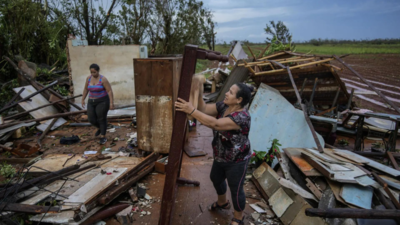
People recover belongings from their houses, which were destroyed by Hurricane Rafael, in Alquizar, Cuba. (Picture credit: AP)
Southern Cuba was struck by two powerful earthquakes on Sunday, just days after the island was battered by
Hurricane Rafael
and Oscar.
According to the US Geological Survey, the first tremor, measuring 5.9 magnitude, occurred at around 11 am (local time) off the coast of Bartolome Maso in Granma province. An hour later, a more intense 6.8 magnitude quake hit the same area at a depth of 14.6 miles.
The quakes caused widespread panic, with residents rushing into the streets in fear, especially after enduring severe weather conditions earlier in the week.
Despite the severe impact, the US Tsunami Warning System confirmed that there was no tsunami threat from the earthquakes.
The earthquakes damaged homes and infrastructure, particularly in eastern and central Cuba. State media reported cracked walls, collapsed roofs, and damaged power lines in towns like Bayamo, Santiago de Cuba, and Caney de las Mercedes.
According to the news agency AFP, no fatalities have been reported so far despite the damage.
The quakes have compounded the difficulties for many residents who are already facing hours-long power cuts and a severe economic crisis marked by soaring inflation and shortages of basic goods.
Residents of Bayamo, a city with a population of around 140,000, described the intense shaking, with street poles swaying and homes rattling. In Santiago de Cuba, the island's second-largest city, buildings trembled, and people scrambled to safety.
Livan Chavez, a welder from Bayamo, told AFP, "People got scared. Everyone came running out of the houses very scared." Another resident, Karen Rodriguez, noted that some homes in her small town had walls and roofs collapse.
These tremors come as Cuba struggles to recover from a series of natural and man-made disasters. The island was recently hit by
Hurricane Oscar
, which caused widespread damage, and Hurricane Rafael, which knocked out the national power grid, leaving millions without electricity.
The ongoing crisis has sparked rare protests, leading to the arrest of several individuals, as residents voiced their frustration over the prolonged blackouts and worsening living conditions.
Cuban President Miguel Diaz-Canel
addressed the nation via social media, acknowledging the damage and promising that efforts to assess and repair the destruction were underway. He emphasised that the government's priority is to "save lives" amidst these overlapping crises.
The region around Santiago de Cuba is no stranger to seismic activity, as it sits near the fault line separating the North American and Caribbean plates. Local experts reported that over 15 aftershocks were felt following the initial quakes, prompting authorities to warn residents to stay alert for further tremors.
The dual disasters of hurricanes and earthquakes have left much of Cuba’s eastern region in dire need of aid and recovery efforts.

 1 month ago
10
1 month ago
10










 English (US) ·
English (US) ·